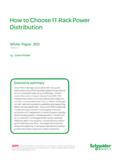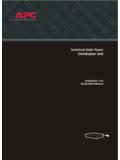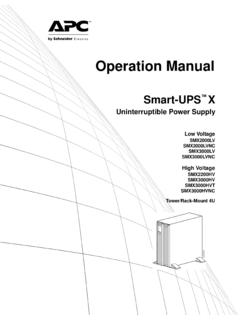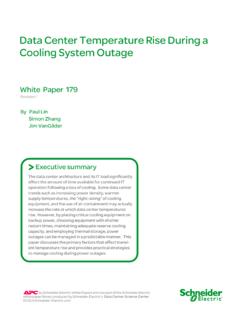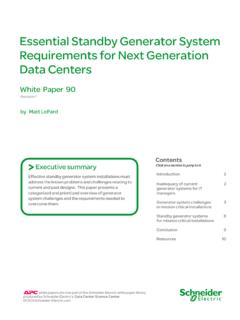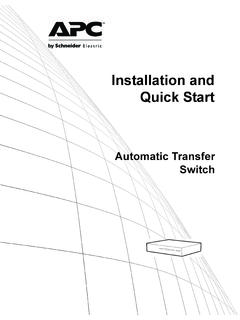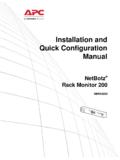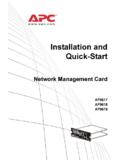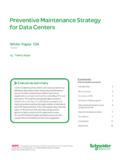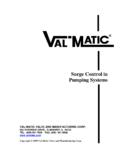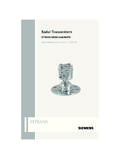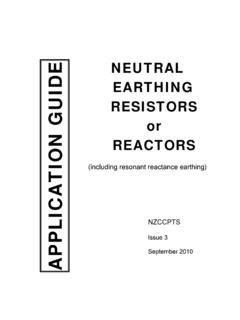Transcription of Data Line Transient Protection - - APC USA
1 data line Transient Protection Revision 1 by Joseph Seymour Introduction 2 How transients are created3 Effects of transients4 Transient suppression and Protection 6 Conclusion 9 Resources 10 Click on a section to jump to it Contents White Paper 85 Electrical transients (surges) on data lines can destroy computing equipment both in the business and home office environments. Many users appreciate the risk of power surges but overlook data line surges.
2 This white paper explains how transients are created, how they can have devastating effects on electrical equipment, and how surge suppression devices work to help protect against them. Executive summary> white papers are now part of the Schneider Electric white paper libraryproduced by Schneider Electric s data Center Science Center data line Transient Protection Schneider Electric data Center Science Center White Paper 85 Rev 1 2 Electrical disturbances pose a great threat to electrical equipment and data . Electrical disturbances go by various names such as spikes, surges, and Transient surge voltages.
3 Regardless of the name, the effects of these disturbances remain the same: disruption, degradation and damage, which inevitably mean equipment downtime. With the increasing popularity of computer networking, the effect of Transient surges on communication lines is also of great importance. Communication lines entering a building, whether below or aboveground, can transfer large transients into a home or business facility. Created through various kinds of coupling (transmission of electrical energy from one system to another through magnetic fields), Transient surges may cause serious damage to communication interfaces inside a building. Due to the many ways a Transient surge may be created, a single surge suppression layer applied to incoming lines may not be appropriate to complete-ly shield the internal lines and equipment from Transient voltages.
4 When discussing the specific effects that a Transient surge can have on data lines, it is important to understand in general terms what data lines are and how the carry data in the form of electricity. A data line is a conductive communication cable that carries low level voltages for the purpose of communication between attached devices. Some common examples of data cables are coax, CAT5 Ethernet cable, and telephone cable. data is transferred from one piece of equipment to another by sending varying voltage levels from transmitting equipment across data lines to the receiving equipment on the other end of the cable. The receiving equipment processes the voltage levels, interpreting and translating them into data that it understands and follows.
5 Even though data lines have a tendency to carry only low voltage levels, they are made of a conductive material and are subject to the same Transient surges and spikes that other conductive lines may experience. In general, a Transient surge is a short-term deviation from a desired voltage level (or signal in the case of computers and electronic devices). This undesirable deviation can cause an electronic device to malfunction or even fail. Some equipment used to communicate over data lines is only designed to function within a very low threshold of voltage, and can easily be damaged if voltage levels rise above what is desira-ble. Furthermore, Transient voltage surges are created from a variety of sources, which means no configuration of equipment is free from transients.
6 Figure 1 illustrates the results of a study produced by Florida Power that separates power quality problems into various groups. The chart shows that lightning attributes 15% of power quality issues, utility sub-stations introducing transients through grid switching attributes only 5%, and that transients generated by office equipment accounts for 60% of all power quality problems. Office Introduction Figure 1 Florida Power study of the breakdown of power quality problems in the business place data line Transient Protection Schneider Electric data Center Science Center White Paper 85 Rev 1 3 Transients can be present on any conductor such as utility power lines, telephone, data , and signal lines.
7 The types of data lines that exist on many Local Area Networks (LANs) include RS-232, RS-422, Ethernet and Token Ring Cable, closed-circuit TV, surveillance alarm systems, and CNC/machine-tool interfaces. Spikes, a type of Transient surge, are short-term over-voltages, which are usually measured in milliseconds. This unwanted excess of electrical energy could be created easily on any conductive line . The energy content of transients can be enormous and can damage equipment, or cause it to malfunction by giving faulty signals due to inaccurate voltage levels. Equipment driven by microprocessors and other integrated circuits (IC) are especially vulnerable to Transient voltage surges.
8 Inductive coupling, created from various sources, is usually the cause for transients specific to data lines. Lesser known than how direct AC power transients are created, is how inductive coupling transients are produced on data lines. Whenever electric current flows through a conductive material, a magnetic field is created. If a second conductor is placed within the magnetic field of the first conductor, and the magnetic field is in a state of flux, then the magnetic field will induce a current on the second conductor. The use of a magnetic field to create current and induce voltage, without actually connecting physically to the other conductive material, is the basis for transformer operation such as the ones used for utility power lines.
9 A transformer produces a magnetic field extending from a coiled wire in the primary, which induces a voltage in the coiled wire of the secondary. Under the same principles, wires that run adjacent to one another within a building can magnetically couple transients, as shown in Figure 2. This coupling can be caused by a power line , which induces a voltage in an adjacent data line , or from one data line to another (which is usually referred to as crosstalk). Magnetic FluxPowerLineDataLineInduces currentflow Lightning can cause a much more powerful kind of magnetic coupling, which can cause sudden damages to multiple items in a single strike. Figure 3 shows a lightning bolt striking the ground.
10 This lightning bolt is surrounded by a very powerful magnetic field. In much the same way a magnetic field from one conductor can induce transients on an adjacent conduc-tor, the magnetic field of a lightning strike can induce power in an external power line without actually striking the line directly. More importantly, if a lightning strike is close enough to a facility it can induce transients on internal data lines that its magnetic field cuts across. These transients can confuse data being transferred over these lines or likely cause damage How transients are created Figure 2 Inductive coupling data line Transient Protection Schneider Electric data Center Science Center White Paper 85 Rev 1 4 to attached equipment.
